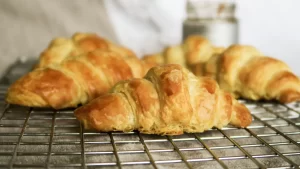Mastering the art of buttery French croissants requires a keen eye and precise technique. Each stage, from kneading the dough to achieving the perfect golden hue in the oven, demands attention to detail. The texture of the dough and the evenness of its layers are essential. Observing these elements can transform a simple pastry into an exquisite creation. Yet, many bakers overlook vital steps that can elevate their croissants to new heights.
Key Takeaways
- Use high-quality unsalted butter and flour rich in gluten for a rich, flaky texture in your croissants.
- Perfect your lamination technique by encasing cold butter within the dough, ensuring precise rolling and folding for airy layers.
- Shape croissants by cutting dough into triangles and rolling tightly from the wide base to achieve the classic crescent form.
- Proof the shaped croissants in a warm, draft-free space to activate yeast and encourage a light, airy rise.
- Bake at a high temperature and incorporate steam for a golden, flaky crust, monitoring closely for perfect color.
Understanding the Ingredients for Perfect Croissants
To achieve the perfect buttery French croissants, one must first appreciate the essential ingredients that contribute to their exquisite flavor and texture. Flour, rich in gluten, forms the backbone of the dough, providing structure. High-quality unsalted butter is fundamental, as its fat content lends the croissant its signature flakiness and rich taste. The inclusion of milk enhances the dough’s tenderness, while a touch of sugar balances flavors and promotes browning. Yeast is critical for the rise, creating those delightful airy layers. Finally, salt elevates the overall taste, ensuring each bite is harmonious. Understanding these ingredients is key for anyone keen to learn how to make buttery French croissants, fostering a sense of connection and accomplishment in the kitchen.
Mastering the Dough: Techniques for Flaky Layers
With a solid understanding of the ingredients, the next step in mastering how to make buttery French croissants involves perfecting the dough itself. Achieving an exquisite texture requires meticulous attention to detail. The dough must be kneaded until it becomes smooth and elastic, allowing gluten to develop. This process guarantees a strong structure that will support the flaky layers to come. Once the dough has risen, it’s essential to roll it out evenly, creating a thin canvas that will encase the butter. The temperature of both the dough and butter plays a pivotal role; they should be cold but pliable to prevent melting. This delicate balance sets the stage for the magic of layering, promising a delightful experience for all who partake.
The Importance of Lamination in Croissant Making
Lamination serves as the cornerstone of croissant making, transforming simple dough into a masterpiece of flaky, buttery layers. This intricate technique involves encasing cold butter within the dough and repeatedly rolling and folding it to create numerous layers. Each fold introduces air pockets that expand during baking, resulting in a delicate, airy texture that melts in the mouth. The precise temperature and timing are essential; too warm, and the butter melts, compromising the layers, too cold, and the dough becomes unmanageable. Mastering lamination not only enhances flavor but also fosters a sense of community among bakers, allowing them to share techniques and celebrate the artistry of crafting buttery French croissants together.
Shaping and Proofing: Achieving the Ideal Croissant Form
As the dough transforms into its final shape, the process of shaping and proofing becomes essential in achieving the ideal croissant form. The dough, now pliable and layered, is cut into triangles, each edge carefully handled to maintain the delicate structure. Rolling from the wide base to the tip, the croissant takes on its signature crescent shape, with the layers nestled inside for a buttery, flaky texture. Proofing follows, allowing the shaped dough to rise in a warm, draft-free environment. This vital step encourages the yeast to work, expanding the croissants and enhancing their airy quality. With proper shaping and proofing, bakers can create croissants that not only look beautiful but also invite a sense of community and shared indulgence among those who enjoy them.
Baking to Perfection: Tips for Golden, Buttery Croissants
Achieving the perfect bake is essential for creating buttery French croissants that are both visually appealing and delightful to the palate. To guarantee a golden hue, preheat the oven to a high temperature, typically around 400°F (200°C), allowing the heat to envelop the croissants evenly. A steam-filled environment during the first few minutes of baking promotes that coveted flaky texture; a pan of water in the oven can achieve this effect. Timing is critical; croissants should be monitored closely, turning a beautiful golden brown within 15-20 minutes. Finally, let the baked croissants rest briefly before indulging, allowing the buttery flavors to settle. Mastering these techniques will elevate the experience of how to make buttery French croissants, fostering a sense of culinary belonging.
Frequently Asked Questions
Can I Use Whole Wheat Flour for Croissants?
Whole wheat flour can be used for croissants, but it alters texture and flavor. The resulting pastry may be denser and nuttier, appealing to those seeking a healthier twist on the classic buttery French croissant.
How Long Can I Refrigerate Croissant Dough?
Croissant dough can be refrigerated for up to 48 hours. This allows flavors to develop, enhancing the pastry’s buttery richness. Proper wrapping is essential to prevent drying, ensuring the dough remains pliable and ready for baking.
Is It Necessary to Use Organic Butter?
Using organic butter is not strictly necessary, but it enhances flavor and quality. The richness of organic butter can elevate buttery French croissants, appealing to those seeking a superior culinary experience and a sense of community among food enthusiasts.
Can I Freeze Baked Croissants?
Yes, baked croissants can be frozen. Properly wrapped in plastic and stored in an airtight container, they maintain their flaky texture. When ready to enjoy, simply reheat for a delightful, fresh experience.
How Do I Know When Croissants Are Fully Baked?
Croissants are fully baked when they exhibit a golden-brown color, a crisp exterior, and a hollow sound when tapped. The aroma of buttery richness fills the air, signaling their readiness to delight the senses.
Conclusion
To summarize, the journey to mastering buttery French croissants lies in the delicate balance of technique and observation. From the smooth elasticity of the dough to the precise lamination that creates those coveted flaky layers, each step is a visual dance. As the croissants bake to a golden hue, the culmination of careful shaping and proofing transforms mere ingredients into a culinary masterpiece. With practice and attention to detail, anyone can achieve that perfect crescent form that delights the senses.
You May Also Like To Read:


